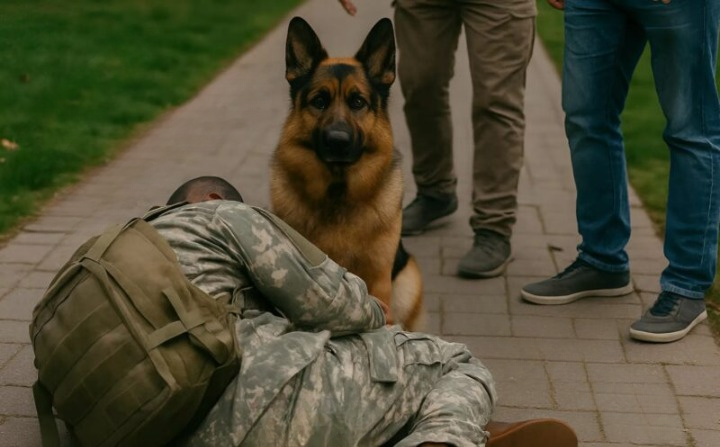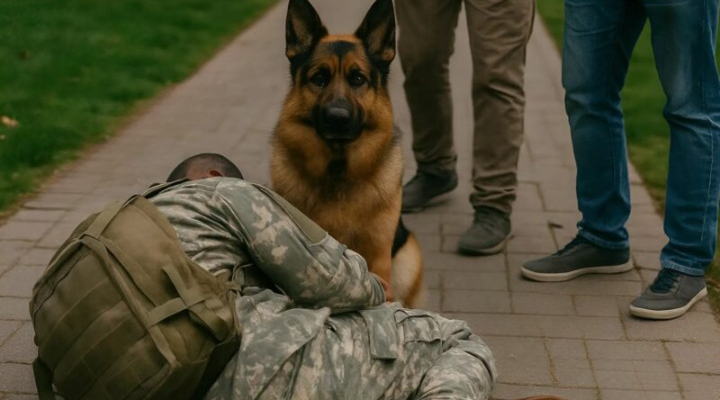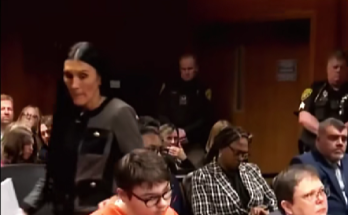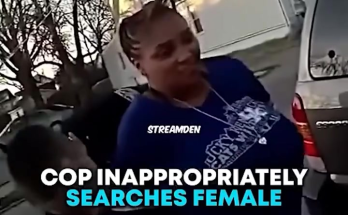It was an ordinary day in the park. Children’s laughter echoed across the paths, people strolled leisurely along winding alleys, and someone tossed crumbs to a flock of pigeons, their wings flapping in excitement. The air carried the warm promise of spring, and nothing seemed out of the ordinary.
My friend and I were wandering along one of the main paths, enjoying the sun and chatting about trivial things, the kind of light conversation that makes a walk feel effortless. But then, something appeared on the horizon that immediately drew our attention: a man in military uniform, carrying a large backpack, walking with a striking German shepherd at his side.
At first, everything looked perfectly normal. The dog trotted obediently beside its master, eyes alert but calm, ears perked in attentive focus. The soldier walked with steady steps, as though accustomed to long treks and heavy loads. But within moments, the ordinary day transformed into a scene that would stay with me forever.
The Collapse
Without warning, the soldier staggered. One second he was walking steadily; the next, he crumpled to the ground, landing with a heavy thud that made our hearts stop. He lay motionless, his uniform slightly askew, the backpack still on his shoulders.
We rushed forward instinctively, calling out, wanting to help. But the German shepherd, who had been calm moments ago, suddenly transformed. Its stance stiffened, teeth bared, a low growl vibrating in its chest. The dog positioned itself directly over its master, circling with precision, eyes burning with intensity.
Every attempt to approach was met with a fierce bark, a warning glare, and a warning growl. We froze, unsure how to proceed. The crowd began to notice. People slowed their walks, paused on benches, or simply watched in wide-eyed silence. The air was heavy with tension—curiosity mixed with fear.
No one dared to move forward. The soldier lay helpless on the ground, yet the dog refused to allow even a single person near him. What was happening? Why would a dog prevent help when its master clearly needed it?
Understanding the Dog’s Behavior
The crowd stood in hesitation, murmuring softly among themselves. The soldier’s chest rose and fell faintly, his breathing shallow, but the German shepherd remained vigilant, growling at anyone who attempted to reach him. It was clear that the dog was not acting out of aggression; its posture and growls spoke of fear, loyalty, and a singular determination to protect.
An elderly woman, observing from the edge of the crowd, finally stepped forward. Her posture was confident, her eyes sharp as she assessed the dog. In a firm but calm voice, she addressed the onlookers:
“He is not vicious,” she said. “He’s afraid of losing his master. If we show him that we mean no harm, he will allow us to help.”
Her words brought a moment of clarity to the crowd. This was not a situation of danger but of loyalty so profound that it demanded respect and careful handling.
Taking the First Step
The elderly woman approached the German shepherd slowly, speaking in a low, soothing tone. She knelt down carefully, keeping her movements deliberate and non-threatening. The dog tensed at first, eyes sharp and body rigid, but as she continued speaking softly, it seemed to process her intentions.
Gradually, the dog stopped growling. It remained alert, but its fury subsided into vigilance. Two more men joined her cautiously—one dialing an emergency number to call an ambulance, the other retrieving a bottle of water. The crowd collectively held its breath. Every movement had to be deliberate, respectful, and patient.
Minutes felt like hours. The dog remained close, circling, watching every hand and foot. Then, finally, after what seemed like an eternity, it allowed the men to carefully roll the soldier onto his back. Relief washed over the crowd. His breathing, though shallow, was steady. He had fainted but was alive.
The Arrival of Medical Assistance
Within minutes, paramedics arrived, quickly assessing the situation and stabilizing the soldier. All the while, the shepherd stayed by his side, whining softly, pacing anxiously, refusing to be separated from its master. Even as the soldier was carefully lifted onto a stretcher and placed into the ambulance, the dog ran alongside, keeping a watchful eye, unwilling to let the vehicle move without him.
It was a scene that left everyone in awe. People whispered to each other, commenting on the dog’s unwavering loyalty, its determination to protect at all costs. The soldiers’ uniform may have commanded respect, but it was the dog’s devotion that captured hearts.
A Lesson in Loyalty
As the ambulance drove away, the crowd began to disperse, but the memory of that moment lingered. We realized that the dog’s behavior wasn’t about aggression—it was about love, loyalty, and understanding. Animals often perceive threats and vulnerabilities that humans miss. The shepherd sensed the fragility of its master’s state and reacted in the only way it knew how: by standing guard, protecting him until help could arrive safely.
Watching the dog follow the ambulance down the street, refusing to leave its master’s side, was both humbling and inspiring. It was a reminder that loyalty is not just a trait but a living, breathing force that can inspire courage and patience in others.
Reflection on the Day
Later, my friend and I reflected on what had happened. In the park that afternoon, we witnessed not only a life-threatening incident but also the extraordinary bond between a soldier and his companion. It was a lesson in empathy, in patience, and in the profound intelligence and intuition of animals.
The dog’s actions reminded us that love and loyalty often come with responsibilities and challenges. It taught us that sometimes, the best way to help is not to rush forward blindly but to observe, understand, and approach with care. In that moment, the crowd learned more about humanity by watching a dog than they could have from any lecture or book.
The Emotional Impact
The incident left a deep impression on everyone present. For some, it was a simple story of a dog protecting its master. For others, it was a profound reminder of the bonds that exist beyond words, between humans and animals, and the incredible capacity for devotion.
Parents used the story as a lesson for children: teaching patience, understanding, and the importance of empathy. Young people were reminded that courage can take many forms—not only human bravery but also the steadfast presence of those who love without hesitation.
For me, it reinforced an idea I had always believed but rarely witnessed so vividly: that loyalty and love can inspire action, calm fear, and even save lives.
The Aftermath
News of the incident quickly spread throughout the neighborhood. Local social media accounts were filled with posts about the loyal dog and the soldier who fainted in the park. People praised the dog’s devotion, calling it heroic. Others discussed the importance of understanding animal behavior and the unique relationships that can form between humans and their pets.
Paramedics confirmed later that the soldier had only lost consciousness due to dehydration and exhaustion, a common risk for soldiers carrying heavy gear in the heat. Thanks to the dog’s protection, he had avoided further injury and received help quickly.
The soldier himself, upon recovery, praised his dog publicly, describing it as “my guardian, my companion, my constant friend.” It was a reminder that animals, especially dogs, can play vital roles in human lives beyond companionship—they can sense danger, offer comfort, and act decisively in moments of crisis.
Lessons Learned
There are several takeaways from this extraordinary event:
- Trust instincts, but act wisely. The crowd wanted to help immediately, but the dog’s protective behavior was a warning to approach with care.
- Loyalty transcends fear. The dog was willing to confront strangers to protect its master, showing that loyalty is not passive—it is active, courageous, and instinctive.
- Empathy bridges gaps. The elderly woman who first approached the dog did so with calm and patience, allowing human assistance to reach the soldier safely. Compassion combined with wisdom can solve seemingly impossible situations.
- Animals perceive more than we realize. Dogs, in particular, can sense vulnerability and danger, sometimes more acutely than humans. Their actions can guide us if we observe carefully.
A Story to Remember
That day in the park, the ordinary became extraordinary. A fainting soldier and a protective dog taught everyone present lessons in patience, understanding, and the power of loyalty. The images of that faithful shepherd, circling and standing guard, will linger in memory as a symbol of devotion and courage.
Sometimes, animals show us the best of human qualities—steadfastness, vigilance, love without condition—and remind us that the bonds we share with them can inspire greatness in ourselves.
Conclusion
We often underestimate the intelligence, empathy, and bravery of animals. But that day, a German shepherd showed everyone that loyalty can protect, guide, and even save a life. The soldier’s fainting could have ended badly if not for the dog’s vigilance, and it was a reminder to all who witnessed the event that courage and devotion take many forms.
As the crowd dispersed, people returned to their daily routines, but the memory of the loyal dog remained vivid. It was a story of love, instinct, and the extraordinary bonds that exist between humans and animals—a story we will not soon forget.
Sometimes, the greatest lessons in life are delivered not by people, but by those who love without condition, act without hesitation, and protect without asking for recognition.




